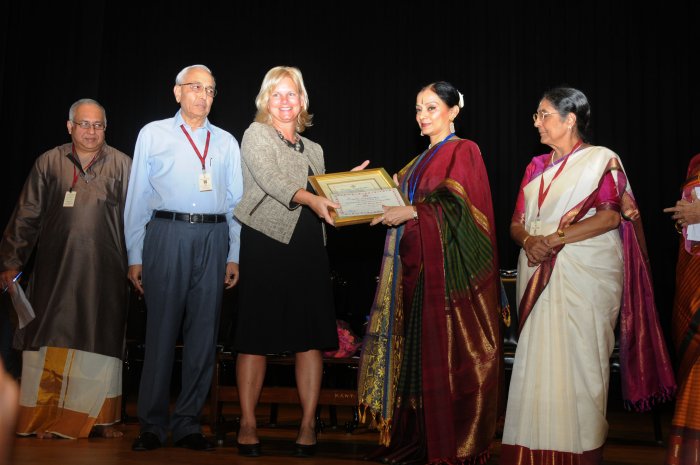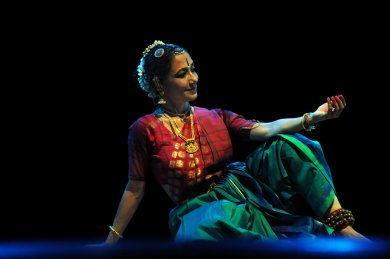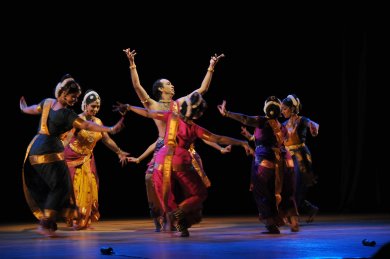
|   |

|   |
The Madras Music Academy Dance Festival - Day 1 - Veejay Sai e-mail: vs.veejaysai@gmail.com Photos: Thanthoni January 5, 2017 The eleventh edition of the prestigious Madras Music Academy’s annual international classical dance festival was inaugurated on the third January. In the last decade, this festival has become a one-point reference for the world of classical dancers. Like the music festival of the Academy, this has also grown in stature to become the signature dance festival of the Margazhi season.  In addition to the main award were several other awards given to Mohiniattam dancer Dr. Methil Devika, the Spirit of Youth awards to Kali Virabhadran, a student of Kalakshetra and Yogesh of Bangalore. For the Academy’s prestigious ‘Sangita Kalanidhi’ award on the 1st of January, year after year, all the former awardees show up. They show up not just in support of the current awardee but as a mark of respect for this hallowed award and the institution. This has been a long undying tradition in the Academy. But no such good stories exist in the dance world. None of the former awardees were to be seen. They can always give excuses of having rehearsals or any other. If senior gurus, especially former awardees, stay away and don’t come together at the opening of a festival curated specially for them, by the most prestigious of spaces, one must think if there is any sense of community or respect for their art, leave alone the institution at all! The charm of the vintage After the award ceremony the inaugural performance was by Leela Samson. Dressed in a shade of turquoise green and pink, Leela began her performance with a viruttam “Ambal Poothavale” set to a Ragamalika in praise of the mother goddess. With great vocals by Radha Badri , this composition of Abhirami Bhattar set the pace for the evening ahead. In the classic Tanjore Quartet varnam “Saami neeve ani chaala nammithini,” in the original Telugu language set to ragam Kalyani and adi talam, Leela showed us the beauty of the vintage. Opening with JB Sruti Sagar’s melodious flute in the comfort of the Kalyani ragam, this less-performed varnam got a new lease of life. Classic old time jatis, a composed footwork to match with, the varnam flowed with great ease. In an act where the nayika believes that her lord will not let her down, she pleads for his compassion. “Jaalamu seyya raaduraa ee vela naa pai,” she says reminding the lord that he cannot ignore her. In the second half of the varnam the construction of the composition was more pronounced using the praasa of ‘Nee’. “Nee vitaramunu, nee sogasunu, nee..,” and one saw Leela deliver crisp abhinayam to the lyrics as the poetry flowed. Aadith Narayanan Seshadri’s excellent nattuvangam and Kartikeyan Ramanathan’s mridangam added refinement to the performance.  The theme of love continued into the next piece, the famous Jayadeva’s ashtapadi ‘Sakhi he’ set to Shuddha Saranga ragam. Opening with the charanam “Nibhruta nikunja,” Leela began with the story of how the nayika who went alone was accosted by Krishna’s looks of love. Asking the Sakhi to bring this Krishna to her, she remembers the first time they made love. If the beauty of the ragam was emoted in one way, Leela delivered the elegance of the poetry in another way. It was a sheer joy to watch her abhinayam for this. There is a lot of talk about how and what Rukmini Devi might have done to the Gita Govindam as presented by students of Kalakshetra. That she masked it with a blanket of unwanted bhakti and so forth. Watching Leela’s presentation of the ashtapadi didn’t invoke any such thoughts. In fact it was a delightful experience to watch how she handled the depth of erotic poetry with her graceful abhinayam. The theme of love once again continued into her next piece where the nayika now calls her lover saying she cannot bear these pangs of separation. In the Dharmapuri javali “Yera ra ra” set to Khamas ragam, the nayika is bold and yet subtle in expressing her desire. Leela’s subtle style of expressing shringaram was a delight to watch. She concluded her performance with a Lalgudi thillana in ragam Revathi. What does one say about an artiste like Leela? She lets her art do the talking. One can only say her art always managed to catch your attention and reveal a new side of the dance form she has been a practitioner of, for all these decades. The flag-bearers of the Vempati baani Kuchipudi is slowly fading from the classical dance scene. The reasons for this tragedy are numerous and the erosion has been over the last couple of decades. Today we barely have half a dozen Kuchipudi dancers worth mentioning. Among those who are persistently doing good work, Jaikishore Mosalikanti and his wife Padmavani Mosalikanti. Despite a lot of setbacks they continue to pursue this art form with great hope and commitment. Their presentation at the Academy was a mixed bag. For one, they stuck to the purity and precision of the Vempati style of choreography in Kuchipudi. Opening their presentation with an invocatory kriti to lord Ganesha, “Ananda Narthana Ganapathim” of Oothukadu Venkata Kavi set to Nata ragam and adi talam, the first reaction was of disbelief on seeing some of the dancers of their group, completely out of shape. The following jatiswaram set to ragam Atana and adi talam was when they really warmed up. Composed by Bokka Appaya Sastry, the choreography reflected the Vempati style. Beginning with Chatursram first and giving into Trisram next, the fast paced jatiswaram saw all the dancers deliver well.  What is Kuchipudi without a Tharangam? Jaikishore and Padmavani presented the famous and oft-performed Narayana Theertha Tharangam “Aalokaye Shri Balakrishnam.” Set to a Ragamalika and adi talam, each line of the composition was elaborated with various stories from Krishna’s leelas. In “Govatsa brinda palaka Krishnam” we saw the episode of Kaliya Mardhana where Padmavani enacted the serpent. In “Navaneeta dhadhi chora” we saw playful episodes of Krishna the butter thief. They performed a ‘Sawaal-Jawaab’ format of Tharangam on the brass plates where each of them responds to the other with a display of footwork. All this was fine but the singer Kuldeep Pai’s anxiety got the better of him. His voice, totally stressed out, wouldn’t stop wailing away throughout the singing. Kuldeep is a fantastic singer. But this day was just not his. Sounding over-rehearsed and fatigued, he kept shouting through the performance without accommodating any of his accompanying artistes. One could barely hear Easwar Ramakrishnan’s melodious violin. On the other side, Aadith Narayanan Seshadri was a maverick! In the last performance we heard him do a contrasting sober nattuvangam for Leela’s Bharatanatyam but in this one, he was in a different avatar. Grasping the vibrancy of the Kuchipudi vocabulary, Aadith showed he was a master in this too! The group was back to perform “Singaarinchukoni,” an excerpt from Tyagaraja’s famous opera ‘Nauka Charitamu’ set to Surati ragam and adi talam. Presenting it in the format of a pathra pravesha daruvu, they told us the stories of how Gopikas adorned themselves waiting for Krishna. The finale was the famous ‘Ananda Thandavam Aade’, written by Jnanpeeth awardee C Narayana Reddy and set to tune by Sangeetha Rao. Opening with lines from Adi Shankara’s Shivanandalahiri, the group showed us the glory of the dancing lord Nataraja as worshipped in the temple town of Chidambaram. If not for the out-of-shape dancers, the program was an otherwise enjoyable experience. They need a lot more fine-tuning from where they are now. The whole performance carried the stamp of the Vempati style of choreography and sophistication. Jaikishore and Padmavani are proud flag-bearers of this tradition. Veejay Sai is a writer, editor and culture critic. |